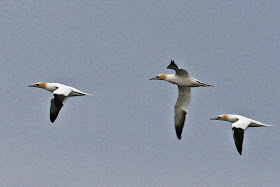This year, the chilly weather of the past winter doesn't seem overly keen to leave us and it is still easy to travel around Cape May and find more birds lingering from the winter than arriving for the summer. Despite this, the county is gradually greening up, CMBO's walks program is now fully under way and great birding adventures are here for the taking. Today saw the last of our early spring Loons and Shorebirds Cruises (fear not, there are still plenty of boat trips to come!) and there was an excellent range of birds scattered throughout the back bay marshes. Boat trips give excellent opportunities to get closer to birds that otherwise would remain distant, out in the middle of the back bays and it was these opportunities that gave me a good collection of flight shots to post here.
So here's a selection of birds winging their way over our waterways and reminding us that birds are well and truly on the move now....
The annual spring spectacle of Northern Gannets passing northward will continue for perhaps another couple of weeks and watching the Delaware Bay from Cape May Point during pretty much any morning in April should provide you with plenty of activity [photo by Mike Crewe].
Check out the various ponds around Cape May Point or at Cox Hall Creek WMA during duller spells of weather and you should find a good collection of swallows and martins hawking insects low over the water. The insects drop lower during overcast conditions, forcing the birds to feed lower too. This Barn Swallow was showing off its snazzy tail and rusty underparts on our walk at The Meadows on Friday [photo by Mike Crewe].
Something of a surprise addition to our Meadows walk was this adult Bonaparte's Gull which was hawking insects over the main ponds there. This species winters with us in good numbers but most individuals have already headed northward before they get the dark hood of breeding plumage, so this bird was a pleasant surprise here [photo by Mike Crewe].
Not all wings over the water are a welcome sight in Cape May. Mute Swans, introduced to North America from Europe, are unarguably beautiful birds, but their persistently aggressive behavior and voracious appetite for native wetland plants makes them seriously detrimental to the health of our wetlands. While some states have shown maturity in tackling the problem head on, New Jersey continues to ignore its responsibility to the health of our wetland habitats and numbers of Mute Swans are rising worryingly here [photo by Mike Crewe].
Good numbers of wintering Brant remain in our back bays now and can be enjoyed at close range on a boat trip. Numbers of this species continue to recover from earlier population crashes and this is now a common species at some coastal saltmarsh locations. In this flight shot, look for the pale tips to the wing coverts, forming narrow white lines across the inner wing on some birds. These markings are indicative of last year's youngsters; birds with all dark wings are adults [photo by Mike Crewe].
Double-crested Cormorants pass through Cape May in great abundance during April and early May and are now acquiring their smart breeding plumage. Many waterbirds also have color changes in their bills and other unfeathered areas - note the speckled bill, brilliant green eye and glowing yellow throat of this bird [photo by Mike Crewe].
Another late hanger-on, Red-breasted Mergansers were pretty common around Jarvis Sound today, but all but a handful of stragglers will leave over the next few weeks [photo by Mike Crewe].
A reminder of the harsh winter experienced to the north of us this year, Red-necked Grebes can still be found in Cape May's back bay wetlands and we saw four on today's boat trip - including this one which was trying that old walking on water trick in Cape May Harbor [photo by Mike Crewe].
Also a hang-over from the winter period, one or two Horned Grebes (like this one on Sunset Lake today) remain and are now well into their breeding finery. This shot shows just how grebes are so highly adapted to swimming and why they have so much trouble trying to walk - their feet are set right at the back of the body and project noticeably in flight [photo by Mike Crewe].
But its not all departures, as demonstrated by these newly-arrived Eastern Willets today. Willets are rather plain-looking birds when stood on the ground but, launching themselves into the air, they reveal a startling black and white wing pattern [photo by Mike Crewe].
Day by day, almost minute by minute, you can feel the excitement and urgency of spring. It takes a lot to beat a busy spring day at Cape May when the migrants are in town!









